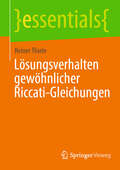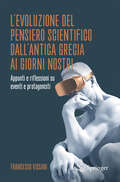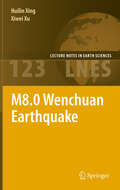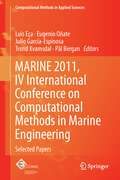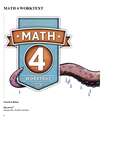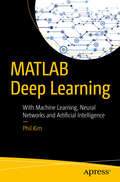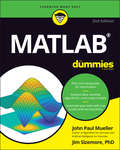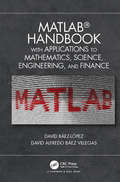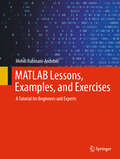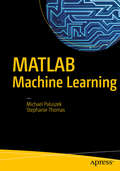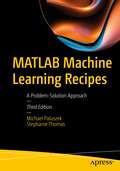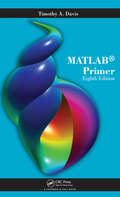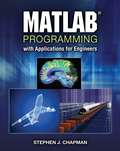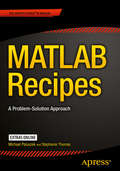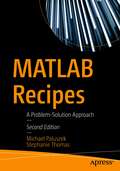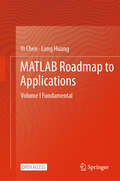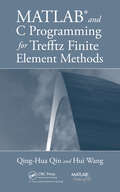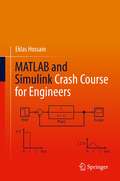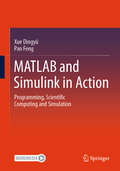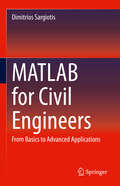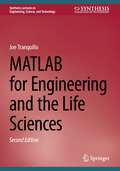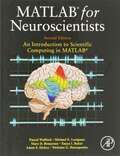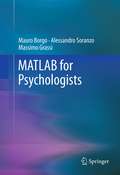- Table View
- List View
Lösungsverhalten gewöhnlicher Riccati-Gleichungen (essentials)
by Reiner ThieleDas Buch vermittelt zielführende Algorithmen zur Lösung gewöhnlicher Riccati-Differenzialgleichungen (DGL). Man verwendet sie zum Design potenzialgetrennter Faraday-Effekt-Stromsensoren. Neu ist die Applikation von Partiallösungen, wobei man sich eine erste Teillösung vorgibt und eine zweite passend zur ersten bestimmt. Außerdem kreiert Reiner Thiele analoge Netzwerke zur Signalverarbeitung sowie Simulationsdiagramme für diese DGL und erläutert, dass es sich bei der Hardware um spezielle Regelkreise handelt.
Lösungsverhalten partieller Riccati-Gleichungen (essentials)
by Reiner ThieleDas Buch vermittelt Lösungsverfahren für partielle Riccati-Differenzialgleichungen (DGL). Diese DGL appliziert man zur mathematischen Beschreibung der Funktion von Faraday-Effekt-Stromsensoren. Ausgehend vom allgemeinen Lösungsverhalten erfolgt die Definition des individuellen sowie kollektiven Lösungsverhaltens einer beliebigen Gleichung. Reiner Thiele erklärt den Unterschied zwischen Individual- und Partiallösungen. Außerdem kreiert er Simulationsdiagramme und zeigt, dass es sich bei der Hardware um Regelkreise handelt.
L’evoluzione del pensiero scientifico dall’antica Grecia ai giorni nostri: Appunti e riflessioni su eventi e protagonisti
by Francesco VissaniLa scienza, come ogni cosa al mondo, ha avuto un inizio, un'origine. Sebbene non si possa stabilire con precisione il momento esatto degli esordi, il contributo della civiltà greca, come ampiamente attestato dai documenti, è stato cruciale; molti, tra cui l’autore, lo considerano essenziale per la nascita della scienza come la conosciamo. Il libro esplora l'evoluzione del pensiero scientifico con una raccolta di appunti e saggi che, procedendo in ordine cronologico ma senza seguire una struttura rigida, mantiene la lettura istruttiva e interessante. Si esaminano le prime forme assunte dalla scienza, la fioritura dell'ellenismo, la sua crisi e la sua rinascita, con particolare attenzione ai rapporti con la filosofia. Il viaggio inizia con i presocratici e i pitagorici, concentrandosi su Democrito, Platone e Archimede, e continua con un breve passaggio nell'era romana. Continua con il periodo arabo, per passare al Medioevo, con un riferimento a Dante; giunge infine al Rinascimento e ai pensatori moderni tra cui Galilei. Nell'ultima parte viene presentata la storia di alcune delle grandi scoperte della fisica, evidenziandone le relazioni con il pensiero antico; si conclude ragionando di situazioni contemporanee.
M8.0 Wenchuan Earthquake
by Huilin Xing Xiwei XuThe M8.0 Wenchuan Earthquake occurred in China on May 12, 2008, killing over 69,000 people and displacing millions from their homes. This was one of the most catastrophic natural disasters on record. This book includes 5 chapters describing the tectonic setting and historical earthquakes around the Chuan-Dian region, the nucleation of the Wenchuan earthquake, occurrence and aftershocks. The field observations of earthquake induced surface fractures and building damage, form a major and special part of this book and include a large number of digital photos with accompanying explanantions.
MARINE 2011, IV International Conference on Computational Methods in Marine Engineering
by Eugenio Oñate Julio García-Espinosa Luís Eça Pål Bergan Trond KvamsdalThis book contains selected papers from the Fourth International Conference on Computational Methods in Marine Engineering, held at Instituto Superior Técnico, Technical University of Lisbon, Portugal in September 2011. Nowadays, computational methods are an essential tool of engineering, which includes a major field of interest in marine applications, such as the maritime and offshore industries and engineering challenges related to the marine environment and renewable energies. The 2011 Conference included 8 invited plenary lectures and 86 presentations distributed through 10 thematic sessions that covered many of the most relevant topics of marine engineering today. This book contains 16 selected papers from the Conference that cover "CFD for Offshore Applications", "Fluid-Structure Interaction", "Isogeometric Methods for Marine Engineering", "Marine/Offshore Renewable Energy", "Maneuvering and Seakeeping", "Propulsion and Cavitation" and "Ship Hydrodynamics". The papers were selected with the help of the recognized experts that collaborated in the organization of the thematic sessions of the Conference, which guarantees the high quality of the papers included in this book.
MATH 4 WORKTEXT
by Dickinson Lindsey MEdBJU Press' Math 4 Worktext, 4th ed. develops problem solving skills and teaches students to work out math problems accurately. Each math concept is demonstrated in clear examples before students attempt the exercise problems. Students will gain mastery of multiplication, division, fractions, and geometry. Each chapter concludes with a chapter review and cumulative review to help students retain these math concepts.
MATLAB Deep Learning
by Phil KimThis book consists of six chapters, which can be grouped into three subjects. The first subject is Machine Learning and takes place in Chapter 1. Deep Learning stems from Machine Learning. This implies that if you want to understand the essence of Deep Learning, you have to know the philosophy behind Machine Learning to some extent. Chapter 1 starts with the relationship between Machine Learning and Deep Learning, followed by problem solving strategies and fundamental limitations of Machine Learning. The detailed techniques are not introduced yet. Instead, fundamental concepts that applies to both the neural network and Deep Learning will be covered. The second subject is artificial neural network. Chapters 2-4 focuses on this subject. As Deep Learning is a type of Machine Learning that employs a neural network, the neural network is inseparable from Deep Learning. Chapter 2 starts with the fundamentals of the neural network: principles of its operation, architecture, and learning rules. It also provides the reason that the simple single-layer architecture evolved to the complex multi-layer architecture. Chapter 3 presents the backpropagation algorithm, which is an important and representative learning rule of the neural network and also employed in Deep Learning. This chapter explains how cost functions and learning rules are related and which cost functions are widely employed in Deep Learning. Chapter 4 introduces how to apply the neural network to classification problems. We have allocated a separate section for classification because it is currently the most prevailing application of Machine Learning. For example, image recognition, one of the primary applications of Deep Learning, is a classification problem. The third topic is Deep Learning. It is the main topic of this book as well. Deep Learning is covered in Chapters 5 and 6. Chapter 5 introduces the drivers that enables Deep Learning to yield excellent performance. For a better understanding, it starts with the history of barriers and solutions of Deep Learning. Chapter 6 covers the convolution neural network, which is representative of Deep Learning techniques. The convolution neural network is second-to-none in terms of image recognition. This chapter starts with an introduction of the basic concept and architecture of the convolution neural network as it compares with the previous image recognition algorithms. It is followed by an explanation of the roles and operations of the convolution layer and pooling layer, which act as essential components of the convolution neural network. The chapter concludes with an example of digit image recognition using the convolution neural network and investigates the evolution of the image throughout the layers.
MATLAB For Dummies
by John Paul Mueller Jim SizemoreGo from total MATLAB newbie to plotting graphs and solving equations in a flash! MATLAB is one of the most powerful and commonly used tools in the STEM field. But did you know it doesn’t take an advanced degree or a ton of computer experience to learn it? MATLAB For Dummies is the roadmap you’ve been looking for to simplify and explain this feature-filled tool. This handy reference walks you through every step of the way as you learn the MATLAB language and environment inside-and-out. Starting with straightforward basics before moving on to more advanced material like Live Functions and Live Scripts, this easy-to-read guide shows you how to make your way around MATLAB with screenshots and newly updated procedures. It includes: A comprehensive introduction to installing MATLAB, using its interface, and creating and saving your first file Fully updated to include the 2020 and 2021 updates to MATLAB, with all-new screenshots and up-to-date procedures Enhanced debugging procedures and use of the Symbolic Math Toolbox Brand new instruction on working with Live Scripts and Live Functions, designing classes, creating apps, and building projects Intuitive walkthroughs for MATLAB’s advanced features, including importing and exporting data and publishing your work Perfect for STEM students and new professionals ready to master one of the most powerful tools in the fields of engineering, mathematics, and computing, MATLAB For Dummies is the simplest way to go from complete newbie to power user faster than you would have thought possible.
MATLAB Handbook with Applications to Mathematics, Science, Engineering, and Finance
by Jose Miguel David Baez-Lopez David Alfredo Baez VillegasThe purpose of this handbook is to allow users to learn and master the mathematics software package MATLAB®, as well as to serve as a quick reference to some of the most used instructions in the package. A unique feature of this handbook is that it can be used by the novice and by experienced users alike. For experienced users, it has four chapters with examples and applications in engineering, finance, physics, and optimization. Exercises are included, along with solutions available for the interested reader on the book’s web page. These exercises are a complement for the interested reader who wishes to get a deeper understanding of MATLAB. <P><P>Features <P><P>Covers both MATLAB and introduction to Simulink <P><P>Covers the use of GUIs in MATLAB and Simulink <P><P>Offers downloadable examples and programs from the handbook’s website <P><P>Provides an introduction to object oriented programming using MATLAB <P><P>Includes applications from many areas <P><P>Includes the realization of executable files for MATLAB programs and Simulink models
MATLAB Lessons, Examples, and Exercises: A Tutorial for Beginners and Experts
by Mehdi Rahmani-AndebiliMATLAB Lessons, Examples, and Exercises: A Tutorial for Beginners and Experts is a book for anyone interested in learning MATLAB, a popular programming language used in mathematics, engineering, and science. Whether you’re a student, instructor, engineer, or technical professional, this book provides easy-to-follow lessons, examples, and exercises in each section of every chapter, emphasizing writing and executing code to help you become proficient in programming with MATLAB. Different colors make the code, outputs, and program descriptions more straightforward to read to improve reader comprehension. The book covers all the essential functions of MATLAB that are needed in math, engineering, and science, and it explains the math behind each function so you can apply them to solve real-world problems. Whether you’re new to programming or an expert, this book offers clear explanations, diverse examples, and hands-on exercises to help you improve your MATLAB programming skills and understand how to use MATLAB in various fields.
MATLAB Machine Learning
by Stephanie Thomas Michael PaluszekThis book is a comprehensive guide to machine learning with worked examples in MATLAB. It starts with an overview of the history of Artificial Intelligence and automatic control and how the field of machine learning grew from these. It provides descriptions of all major areas in machine learning. The book reviews commercially available packages for machine learning and shows how they fit into the field. The book then shows how MATLAB can be used to solve machine learning problems and how MATLAB graphics can enhance the programmer's understanding of the results and help users of their software grasp the results. Machine Learning can be very mathematical. The mathematics for each area is introduced in a clear and concise form so that even casual readers can understand the math. Readers from all areas of engineering will see connections to what they know and will learn new technology. The book then provides complete solutions in MATLAB for several important problems in machine learning including face identification, autonomous driving, and data classification. Full source code is provided for all of the examples and applications in the book. What you'll learn: An overview of the field of machine learning Commercial and open source packages in MATLAB How to use MATLAB for programming and building machine learning applications MATLAB graphics for machine learning Practical real world examples in MATLAB for major applications of machine learning in big data Who is this book for: The primary audiences are engineers and engineering students wanting a comprehensive and practical introduction to machine learning.
MATLAB Machine Learning Recipes: A Problem-Solution Approach
by Stephanie Thomas Michael PaluszekHarness the power of MATLAB to resolve a wide range of machine learning challenges. This new and updated third edition provides examples of technologies critical to machine learning. Each example solves a real-world problem, and all code provided is executable. You can easily look up a particular problem and follow the steps in the solution.This book has something for everyone interested in machine learning. It also has material that will allow those with an interest in other technology areas to see how machine learning and MATLAB can help them solve problems in their areas of expertise. The chapter on data representation and MATLAB graphics includes new data types and additional graphics. Chapters on fuzzy logic, simple neural nets, and autonomous driving have new examples added. And there is a new chapter on spacecraft attitude determination using neural nets. Authors Michael Paluszek and Stephanie Thomas show how all of these technologies allow you to build sophisticated applications to solve problems with pattern recognition, autonomous driving, expert systems, and much more.What You Will LearnWrite code for machine learning, adaptive control, and estimation using MATLABUse MATLAB graphics and visualization tools for machine learningBecome familiar with neural netsBuild expert systemsUnderstand adaptive controlGain knowledge of Kalman FiltersWho This Book Is ForSoftware engineers, control engineers, university faculty, undergraduate and graduate students, hobbyists.
MATLAB Primer
by Timothy A. DavisHighlighting the new aspects of MATLAB 7.10 and expanding on many existing features, this eighth edition continues to offer a hands-on, step-by-step introduction to using the powerful tools of MATLAB. It includes a new chapter on object-oriented programming, a new discussion of the MATLAB File Exchange window, major changes to the MATLAB Editor, and an explanation of more powerful Help tools. It also presents a synopsis of the most frequently used functions, operators, and special characters-providing quick and easy access to frequently used information. M-files and MEX-files for large examples are available at www.crcpress.com
MATLAB Programming with Applications for Engineers
by Stephen J. ChapmanThis textbook seeks to simultaneously teach MATLAB as a technical programming language while introducing the student to many of the practical functions that make solving problems in MATLAB so much easier than in other languages. It provides a complete introduction to the fundamentals of good procedural programming and aids students in developing good design habits that will serve them well in any other language that they may pick up later.
MATLAB Recipes
by Stephanie Thomas Michael PaluszekLearn from state-of-the-art examples in robotics, motors, detection filters, chemical processes, aircraft, and spacecraft. MATLAB Recipes: A Problem-Solution Approach is a practical reference for industry engineers using MATLAB to solve everyday problems. With this book you will review contemporary MATLAB coding including the latest language features and use MATLAB as a software development environment including code organization, GUI development, and algorithm design and testing. This book provides practical guidance for using MATLAB to build a body of code you can turn to time and again for solving technical problems in your line of work. Develop algorithms, test them, visualize the results, and pass the code along to others to create a functional code base for your firm. What you'll learn Learn how to build industrial-strength toolboxes Move beyond a folder of scripts and create well-organized, reusable MATLAB code modules Leverage MATLAB as an IDE and not just a programming language Build a functional code base for your company or department Create your own GUIs for repeatable workflows Who this book is for This book is written for engineers and scientists who use MATLAB on a regular basis and who want to take their coding to a higher level, i. e. people who want to make commercial-quality MATLAB toolboxes. This book may be used by students who are required to use MATLAB for their courses and projects as well as professionals who use MATLAB to solve problems on the job. Table of Contents Part I: Coding in MATLAB 1. Coding Basics 2. MATLAB Style 3. Visualization 4. Interactive Graphics 5. Testing and Debugging Part II: Applications 6. The Double Integrator 7. Robotics 8. Electrical Motor 9. Fault Detection 10. Chemical Processes 11. Aircraft 12. Spacecraft
MATLAB Recipes: A Problem-Solution Approach
by Stephanie Thomas Michael PaluszekLearn from state-of-the-art examples in robotics, motors, detection filters, chemical processes, aircraft, and spacecraft. With this book you will review contemporary MATLAB coding including the latest MATLAB language features and use MATLAB as a software development environment including code organization, GUI development, and algorithm design and testing. Features now covered include the new graph and digraph classes for charts and networks; interactive documents that combine text, code, and output; a new development environment for building apps; locally defined functions in scripts; automatic expansion of dimensions; tall arrays for big data; the new string type; new functions to encode/decode JSON; handling non-English languages; the new class architecture; the Mocking framework; an engine API for Java; the cloud-based MATLAB desktop; the memoize function; and heatmap charts. MATLAB Recipes: A Problem-Solution Approach, Second Edition provides practical, hands-on code snippets and guidance for using MATLAB to build a body of code you can turn to time and again for solving technical problems in your work. Develop algorithms, test them, visualize the results, and pass the code along to others to create a functional code base for your firm. What You Will Learn Get up to date with the latest MATLAB up to and including MATLAB 2020bCode in MATLAB Write applications in MATLAB Build your own toolbox of MATLAB code to increase your efficiency and effectiveness Who This Book Is For Engineers, data scientists, and students wanting a book rich in examples using MATLAB.
MATLAB Roadmap to Applications: Volume I Fundamental
by Yi Chen Long HuangThis open access book presents a comprehensive guide to MATLAB programming, catering to students, engineers, and researchers seeking to harness MATLAB as a powerful tool for their work. The text meticulously covers fundamental concepts, progressing from basic elements such as types and operators to more complex structures like arrays and matrices. It elucidates key programming constructs including selection statements, loop structures, scripts, and functions, providing readers with a solid foundation in MATLAB programming. The book's structure is carefully crafted to facilitate step-by-step learning, with each chapter building upon previous knowledge. Abundant examples and exercises reinforce understanding, while dedicated sections on data visualisation, algorithm development, and practical applications in engineering, science, and finance demonstrate MATLAB's versatility across disciplines. A distinguishing feature of this volume is its inclusion of laboratory work and coursework, allowing readers to apply theoretical concepts to real-world scenarios. This hands-on approach enhances the learning experience and prepares users for practical implementation of MATLAB in their respective fields. In the current era of artificial intelligence, this book serves as an essential resource for those seeking to leverage MATLAB's capabilities. It not only equips readers with programming skills but also illustrates how MATLAB can be integrated into cutting-edge research and industry applications.
MATLAB and C Programming for Trefftz Finite Element Methods
by Qing-Hua Qin Hui WangAlthough the Trefftz finite element method (FEM) has become a powerful computational tool in the analysis of plane elasticity, thin and thick plate bending, Poisson's equation, heat conduction, and piezoelectric materials, there are few books that offer a comprehensive computer programming treatment of the subject. Collecting results scattered in t
MATLAB and Simulink Crash Course for Engineers
by Eklas HossainMATLAB and Simulink Crash Course for Engineers is a reader-friendly introductory guide to the features, functions, and applications of MATLAB and Simulink. The book provides readers with real-world examples, exercises, and applications, and offers highly illustrated, step-by-step demonstrations of techniques for the modelling and simulation of complex systems. MATLAB coverage includes vectors and matrices, programs and functions, complex numbers, visualization, solving equations, numerical methods, optimization problems, and graphical user interfaces. The Simulink coverage includes commonly used Simulink blocks, control system simulation, electrical circuit analysis, electric power systems, power electronics, and renewable energy technology. This powerful tutorial is a great resource for students, engineers, and other busy technical professionals who need to quickly acquire a solid understanding of MATLAB and Simulink.
MATLAB and Simulink in Action: Programming, Scientific Computing and Simulation
by Dingyü Xue Feng PanThe textbook is intended for teaching MATLAB language and its applications. The book is composed of three parts: MATLAB programming, scientific computing with MATLAB, and system simulation with Simulink. Since MATLAB is widely used in all fields of science and engineering, a good introduction to the language can not only help students learn how to use it to solve practical problems, but also provide them with the skills to use MATLAB independently in their later courses and research. The three parts of the book are well-balanced and tailored to the needs of engineering students, and the mathematical problems commonly encountered in engineering can be easily solved using MATLAB. This textbook is suitable for undergraduate and graduate students majoring in science and engineering.
MATLAB for Civil Engineers: From Basics to Advanced Applications
by Dimitrios SargiotisThis book is a comprehensive and rigorous guide to MATLAB for Civil Engineers, bridging the critical gap between theoretical mathematics and practical engineering solutions. With an approachable introduction for students and deep insights for experienced professionals, it caters to a wide range of audiences across civil engineering disciplines—environmental, structural, geotechnical, and transportation engineering. Structured to guide readers progressively, the book begins with foundational MATLAB operations such as syntax and matrix manipulation, then advances into sophisticated engineering applications, including optimization, numerical methods, and data visualization. It covers essential MATLAB functionalities, offering detailed instruction on computation, visualization, and programming, all within the context of solving real-world engineering challenges. What sets this book apart is its hands-on approach. Readers are immersed in practical learning through real-world case studies, examples, and step-by-step exercises designed to reinforce key concepts. The text provides both academic and professional readers with the tools they need to model, analyze, and optimize engineering systems using MATLAB, ensuring they are equipped to handle both routine and complex engineering challenges with confidence. By the end, readers will not only master MATLAB's powerful tools but will also understand how to apply them directly to critical civil engineering problems, positioning themselves to innovate and lead in a field where computational proficiency is increasingly essential.
MATLAB for Engineering and the Life Sciences (Synthesis Lectures on Engineering, Science, and Technology)
by Joe TranquilloThis book is a self-guided tour of MATLAB for engineers and life scientists. It introduces the most commonly used programming techniques through biologically inspired examples. Although the text is written for undergraduates, graduate students and academics, as well as those in industry, will find value in learning MATLAB. The book takes the emphasis off of learning syntax so that the reader can focus more on algorithmic thinking. Although it is not assumed that the reader has taken differential equations or a linear algebra class, there are short introductions to many of these concepts. Following a short history of computing, the MATLAB environment is introduced. Next, vectors and matrices are discussed, followed by matrix-vector operations. The core programming elements of MATLAB are introduced in three successive chapters on scripts, loops, and conditional logic. The last three chapters outline how to manage the input and output of data, create professional quality graphics and find and use MATLAB toolboxes. Throughout, biomedical and life science examples are used to illustrate MATLAB's capabilities.
MATLAB for Neuroscientists: An Introduction to Scientific Computing in MATLAB
by Pascal Wallisch Michael E. Lusignan Marc D. Benayoun Tanya I. Baker Adam Seth Dickey Nicholas G. HatsopoulosMATLAB for Neuroscientists serves as the only complete study manual and teaching resource for MATLAB, the globally accepted standard for scientific computing, in the neurosciences and psychology. This unique introduction can be used to learn the entire empirical and experimental process (including stimulus generation, experimental control, data collection, data analysis, modeling, and more), and the 2nd Edition continues to ensure that a wide variety of computational problems can be addressed in a single programming environment. This updated edition features additional material on the creation of visual stimuli, advanced psychophysics, analysis of LFP data, choice probabilities, synchrony, and advanced spectral analysis. Users at a variety of levels―advanced undergraduates, beginning graduate students, and researchers looking to modernize their skills―will learn to design and implement their own analytical tools, and gain the fluency required to meet the computational needs of neuroscience practitioners.
MATLAB for Psychologists
by Alessandro Soranzo Mauro Borgo Massimo GrassiThe matrix laboratory interactive computing environment--MATLAB--has brought creativity to research in diverse disciplines, particularly in designing and programming experiments. More commonly used in mathematics and the sciences, it also lends itself to a variety of applications across the field of psychology. For the novice looking to use it in experimental psychology research, though, becoming familiar with MATLAB can be a daunting task. MATLAB for Psychologists expertly guides readers through the component steps, skills, and operations of the software, with plentiful graphics and examples to match the reader's comfort level. Using an extended illustration, this concise volume explains the program's usefulness at any point in an experiment, without the limits imposed by other types of software. And the authors demonstrate the responsiveness of MATLAB to the individual's research needs, whether the task is programming experiments, creating sensory stimuli, running simulations, or calculating statistics for data analysis. Key features of the coverage: Thinking in a matrix way.Handling and plotting data.Guidelines for improved programming, sound, and imaging.Statistical analysis and signal detection theory indexes.The Graphical User Interface.The Psychophysics Toolbox.MATLAB for Psychologists serves a wide audience of advanced undergraduate and graduate level psychology students, professors, and researchers as well as lab technicians involved in programming psychology experiments.
